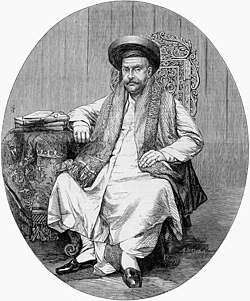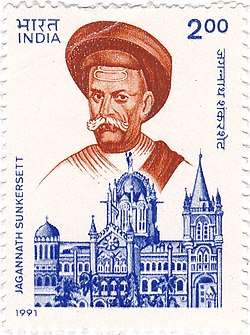Jagannath Shankarseth
Jagannath Shankarsheth Murkute.( 10 February 1803 – 31 July 1865 ) was an Indian philanthropist and educationalist. He was born in 1803 in the wealthy Murkute family of the Daivadnya Brahmin community in Mumbai. Unlike his forefathers, who performed priestly duties for his community, he engaged in commerce and soon developed a reputation as a very reliable businessman. So high was his credit that Arabs, Afghans and other foreign merchants chose to place their treasures in his custody rather than with banks.[1] He soon acquired a large fortune, much of which he donated to the public.
जगंन्नाथ शंकरशेठ Jagannath Shankarsheth | |
|---|---|
 Jagannath Shankarsheth c. 1863 | |
| Born | 10 February 1803 |
| Died | 31 July 1865 |
| Nationality | Indian |

Social and Educational Work
Shankarsheth became an active leader in many arenas of life in Bombay (now Mumbai). Foreseeing the need for improvements in education, he became one of the founders of the School Society and the Native School of Bombay, the first of its kind in Western India.[1] The school went through a series of name changes: in 1824, it became the Bombay Native Institution, in 1840, the Board of Education, and in 1856 the name which continues to this day, the Elphinstone Educational Institution. It is the same institution where, the well known, Balshashtri Jambhekar, Dadabhai Nauroji, Mahadev Govind Ranade, Ramakrishna Gopal Bhandarkar were the students during Nana's period. Later, even Gopal Krishna Gokhale, Lokmanya Tilak had attended the Elphinstone College for studies. When the Students' Literary and Scientific Society first opened their girls' schools,[1] Jagannath Shankarsheth contributed much of the necessary funds, despite strong opposition of some members of the Hindu community. Other educational projects he began include the English School, the Sanskrit Seminary, and the Sanskrit Library,[1] all of which are located in Girgaon, South Mumbai.
Development Works
In 1845, along with Sir Jamsetjee Jeejeebhoy, he formed the Indian Railway Association to bring railways in India. It was his idea and efforts to start Railways in India according to which he had discussed the proposals with British Govt of that time. Eventually, the association was incorporated into the Great Indian Peninsula Railway, and Jeejeebhoy and Shankarsheth became the only two Indians among the ten directors of the GIP railways. As a director, Nana Shankarsheth participated in the very first train journey in India between Bombay and Thane, which took approximately 45 minutes.
Jagannath Shankarsheth, Sir George Birdwood and Dr Bhau Daji were instrumental in some of the major reconstruction efforts of the city, beginning 1857. The three gradually changed a town made up of a close network of streets into a spacious and airy city, adorned with fine avenues and splendid buildings.[1] He became the first Indian to be nominated to the Legislative Council of Bombay under the Act of 1861,[1] and became a member of the Bombay Board of Education. He also was the first Indian member of the Asiatic Society of Mumbai, and is known to have endowed a school and donated land in Grant Road for a theater. His influence was used by Sir John Malcolm to induce the Hindus to acquiesce in the suppression of suttee or widow-burning,[1] and his efforts also paid off after the Hindu community was granted a cremation ground at Sonapur (now Marine Lines). He is known to have donated generously to Hindu temples. During the First War of Independence of 1857, the British suspected his involvement, but acquitted him due to lack of evidence. He died in Mumbai on 31 July 1865. A year after his death a marble statue was erected at the Asiatic Society of Bombay. Erstwhile Girgaum Road and chowk (Nana Chowk) at Grant Road are named after him in South Mumbai.[2]
The Bombay Association was the first political organization in Bombay Presidency founded by Jagannath Shankarsheth on 26 August 1852. Various members were Sir Jamshedji Jejeebhoy, Jagannath Shankarsheth, Naoroji Fursungi, Dr. Bhau Daji Lad, Dadabhai Naoroji and Vinayak Shankarshet. Sir Jamshedji Jejibhai was the first president of the organization.
Family History
Jagannath's ancestor Babulsheth Ganbasheth migrated to Bombay in the mid-18th century from Konkan. Babulsheth's son Shankarsheth was a prominent businessman of South Mumbai in the late-18th century. Gunbow Street (now called Rustom Sidhwa Marg) in the Fort business district of present-day Mumbai, is named after Ganbasheth, and not, as many people assume, is of military origin.[3]
Philanthropy
The Dr. Bhau Daji Lad Museum, formerly The Victoria and Albert Museum, at Byculla in Bombay which was designed by a famous London architect was built with the patronage of many wealthy Indian businessmen and philanthropists like Jagannath, David Sassoon and Sir Jamsetjee Jejeebhoy.
The Bhavani-Shankar Mandir and The Ram Mandir near Nana Chowk were built by Shankarsheth Babulsheth in the early-19th century and are currently in the possession of the Shankarsheth family.
References
- Chisholm, Hugh, ed. (1911). . Encyclopædia Britannica. 24 (11th ed.). Cambridge University Press. p. 801.
- "Mumbai's Elphinstone Station Renamed, Here Are 9 More Stations That Have Unique History". indiatimes.com. 19 July 2018. Retrieved 12 December 2018.
- "Rustom Sidhwa Marg: 'It is tragic only a few remember the fearless crusader, let alone recall his services to nation'". The Indian Express. 20 November 2017. Retrieved 2 March 2020.
Further reading
| Wikimedia Commons has media related to Jaganath Shunkerseth. |
- ^ Jagannath Shankar Shet, Mumbai Meri Jaan, Mumbai News, World Press, 30 January 2008.
- ^ Who was Hon. Jugonnath Sunkersett?; Manoj Nair; Mumbai Mirror; Thursday, 9 March 2006; pg 8.